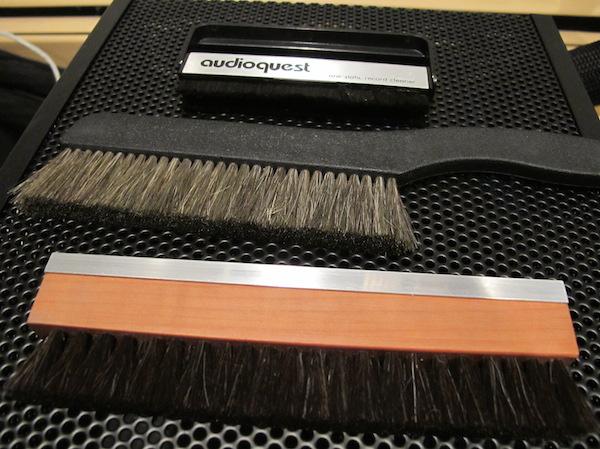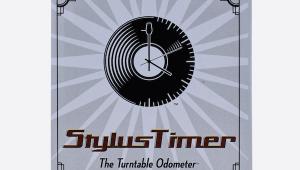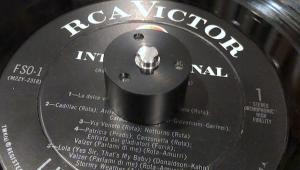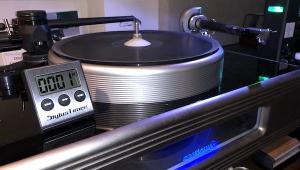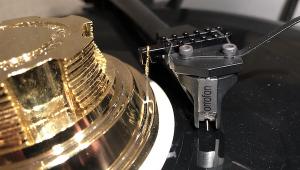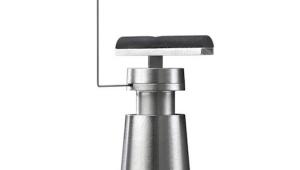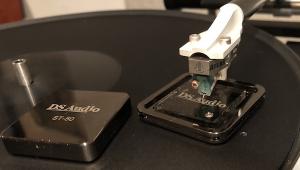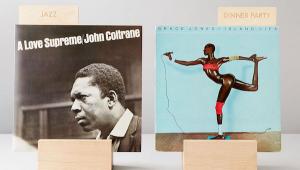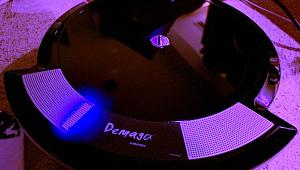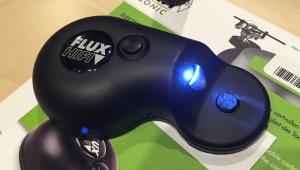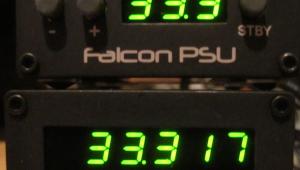Did the AcousTech with the ground wire make any difference in removing static?
The Big Brush Off! Three Dry Record Brushes Compared
The Audioquest features two rows of pure carbon fiber, fine bristles. The AcousTech combines natural fibers and anti-static synthetic bristles and the Levin is 100% natural cashmere goat hair.
Clearly the Levin is most beautiful brush and the most expensive. The Audioquest is the most utilitarian. Cut to the chase: all three did a reasonably good job but the Audioquest was best at both collecting the dust and removing it from the record. Its 100% carbon fiber best lifted the assembled dust from the record.
I like having two rows of bristles. The front set stops the dust and picks up a great deal of it, while the second gets what the first misses. The AcousTech was almost as good but I found that having two separate rows of brushes really made a difference
For the well-to-do audiophile, when guests visit, nothing beats whipping out the Levin brush. It works fairly well and it just looks D-luxe. Obviously, for those on a budget the choice is not difficult between a great looking brush more than a dozen new LPs.
This video was posted for the heck of it. I didn't draw conclusions based on it.
- Log in or register to post comments

In 1985 from Bryn Mawr Stereo in Philadelphia. It doesn't say Audioquest but has Bryn Mawr's logo on it instead. Still in good shape and taking casual dust off of my records 29 years later. It cost $5.00 in 1985.

I've been using the AcousTec brush for several years without feeling the need to try something else. I recently had the the opportunity to try a brush that looked a lot like the audio quest, a flip open style with two rows of bristles. It may well have been audio quest or there may be a generic version of this that is branded. In any case it did seem to work maybe better than mine. It may be that the bristles are shorter thus stiffer than the longer more flexible AcousTech. But since I was used to having to apply a harder downward sweeping force,
when I did that with this other brand at the audio store, it actually scratched the hell out of the complete track of A Whole Lotta Love. Yes, my new Classic! Just at the attachment point there is a sharp aluminum frame that can do serious damage !!
Be warned. I'll try to confirm the offending device.

Have you noticed any of the brushes creating light surface scratches? I used a different technique previously and after using the technique you demonstrated, I noticed very light surface scratches.

Ok, this is gonna sound really out there, but what I do before playing a side is zap it with my zero stat to neutralize the charge, then I use a plastic ketchup dispenser that I got at target for a buck in the kitchen wares (devoid of ketchup, of course) to blow several quick bursts of air which blow all the dust off the record, kind of like a camera blower brush, but bigger so it can make more air. Works great, and better than my carbon fiber brush. That's my story and I'm sticking to it!

I use it. Very happy. Haven't noticed anything remotely resembling scratches but i don't have an electron microscope to verify.

What kind of audiophile are you anyway? You can get one of these for only $60,000.
http://singularityhub.com/2009/12/15/hitachis-desktop-electron-microscop...
You obviously need to take this hobby more seriously.

This has been my constant LP playing companion for many, many years.
I do have my particular (peculiar?) method of using it and like the results better than the Audioquest and its brethren.

...if your sound room is as quiet as mine, you can hear a slight whispering humming when using the carbon fibre brush. That's even with the amp turned off. I think the carbon fibre bristles are so fine that they're tracking and "playing" all the grooves simultaneously just loud enough to hear. (Of course one can hear an unamplified stylus doing the same thing.) I didn't believe it at first until I lifted the brush and reapplied it. I even takes a moment for the humming to fade in and out so I think the bristles are resonating in a type of white noise.

Hey Rick I believe I hear the same type of sound on my project 9.2 .If you have an out board motor like mine,put some friction on the hub.If you hear it then,it might be a motor noise like mine.I have the boys at project looking at it for me now.

...one hasn't got to shell big bucks just to get a record ready to play!

Mike: I have been using various types of dry brushes since the early 70's and have never found them 100% satisfactory. The old Hunt EDA or whatever it was called- two lines of bruehes separated by a felt pad between- did an absolutely spectacular job of sweeping all the surface detritus into a perfect line, but 'scooping' it up off the record was another matter, and an angle to the side to nudge it off seemed to defeat the purpose- transporting all the 'stuff' across the grooves didn't seem to be a good way to 'clean.' Chad's big brush- use it to dust off my platter. The carbon fiber brushes like the Audioquest- always have a fresh one around and that's a decent option to clean milld lint off an otherwise clean record. (I've been resleeving everything after AVIS/Lab Water pre-clean and Audio Desk Ultrasonic with Chad's QRP 'rice paper' sleeves and those still leave lint sometimes on an otherwise pristine record). Remember the StaticMaster- the brush with polonium? Nice brush action that is adjustable but too heavy a charge. Ditto, the Zerostat or whatever that thing is called these days. I used to reverse charge the brush with the Zerostat, but it still didn't help lift the lint or whatever off the surface.
So, I have a love/hate relationship with record brushes and other devices meant to address the surface of a(n otherwise cleaned) record.
I've also found that the spectrum of light affects what you see. I don't know the science concerning color temps and filters as it affects the visibility of this stuff, but my TT light is actually an old brass ship's surgeon's lamp, mounted in the ceiling, with a weird green cast/filter. I can see stuff under that light- before I put the record on the turntable- that isn't revealed under far brighter modern high tech lighting.

I've used both Mapleshade's grounded brush and DAK's carbon fiber (with two rows of bristles and a foam-looking middle layer separating the bristle rows). Seems to me the brushes sit out with bristles exposed and collect dust. How are they going to remove it from the record successfully? If I play a freshly vacuum-cleaned record, it's usually fairly silent (with some of the MoFis and QRPs being dead quiet). If I use the dry brush, it makes it noisier and the record needs to be re-vacuumed. With new LPs, I also wipe the inside of the inner sleeve with a microfiber cloth to remove bits of paper and vinyl (from the center hole punch) that are often there, while trying to be careful not to deposit finger/hand oil. Of course, I'm playing with a relatively humble Rega, which seems much more sensitive to system noise than some higher-mass tables (but I like the Rega's sense of dynamics). If I use a brush, the vinyl seems to get noisier and noisier over time. However, if I put a vacuumed record back in its sleeve after playing, it seems to stay quiet with no additional care or cleaning.

"an absolutely spectacular job of sweeping all the surface detritus into a perfect line, but 'scooping' it up off the record was another matter, and an angle to the side to nudge it off seemed to defeat the purpose- transporting all the 'stuff' across the grooves didn't seem to be a good way to 'clean.'"
This is indisputably true. Even on a day when the Static Gods are on your side, and the dust adheres to the brush or your sleeve or whatever, there is still some left on the record. And then you can either try tricky rotation-and-dismount moves to get the rest, or ignore logic and your own eyes and try the 'angle drag' brush off, which neatly redistributes dust over a wide swath of groove area.
Not sure about the Light factor, but I'm thinking maybe an Arc Light and Welders Goggles as my next upgrade. This is an open field of inquiry.

My favorite is still the Discwasher after having tried a bunch of them. Vintage one only, not the newer one with the dreadful corduroy. And I don't use the Discwasher fluid (yuck), I clean it occasionally with a paper towel lightly sprayed with a mixture of water and isopropyl.

You can do a lot worse. And yes, it needs to be cleaned / groomed regularly so as not to spread dust to the next record. But there comes a time when a filthy un-groomed DW brush is dumpster material.
Agree about the vintage ones. Up until a few years back they could still be found new in the back of some dusty shops. Think an occasional one might show up NOS on ebay, but you'd need to be seeing a good photo to be sure.

Can't mention the DW brush without mentioning that a Whole Lot Of People Are Using It Wrong And Don't Care Much About Learning To Do It Right.
Aside from the critical 'grooming' of the Dw (they used to package a short, stiff-bristled red plastic groomer brush, and gave instructions for use)-- there are simple steps to using the Dw.
The fluid should go in a very thin line down the leading edge of the fabric pad. Which is introduced first, at an angle, to all grooves of the record in a straight radius out from the spindle. The Dw brush is gently rotated, maintaining position, as the record spins, until it has reached the end of the fabric pad, (as far as can be rotated from the leading edge). Then a kind of twist-and-remove motion, up and away from the record, always in a radial position to the grooves, NEVER across the grooves. Groom the brush along the vertical line of the fabric, top to bottom, and done.
The DW brush of the past had explicit instructions on how to do this, and yet, go to any record store and watch both clerks and customers doing it wrong, spreading and ingraining dust, over and over.

In my experience the carbon fiber brush leaves behind small parts of the brush these are so tiny they get stuck in the groove. Use the audioquest brush and use a good light and you will see what I'm talking about.

According to Speakers Corner you should never ever use any brush. The brush push down the dirt into the groves making the vinyl record more noisy over time. The best cleaner is the cartridge itself.

SC said that most of the dirt on a record is on the surface. The brush push this dirt down into the grooves and also creates static that also draws the dirt deeper into the grooves. The needle does not do any of this since it goes inside the groove and does not cause static and also clean the grooves when playing the record. Where the needle is not touching the groove there is no information to pick up anyway.
I'm not saying it's correct. I'm just saying what they say and I think it sounds reasonable :)

What you instead should do is focus on cleaning the needle now and then. They recommended Linn green paper.

Yes a clean needle is paramount - but cleaning discs is so important - I still use a double cabon with "velvet" pad between for a pre-clean before a disc doctor and audio desk systeme. I use a dab of blu-tak to pick up the lines of dust (if there is any). This normally gets the records clean in the first instance. But life is not always perfect. I have put some what I think interesting photos on record cleaning on my blog (backonthetrack.com) a few months ago. PS I have the acoustech brush and think i wasted my money.

Somewhere on the site, you talk about how you specifically brush the record (at a slant during the first revolution, following the grooves, then brushing off the dust, something like that). Do you have the link? My problem is getting the dust off the bristles afterward, it tends to collect.

Before I play a record and after its first initial cleaning with VPI vacuum cleaner. I use the AcousTech The Big Record Brush to remove dust first. Then I use Premier cleaner with the Osage Brush. Then finally I use the Hunt Brush.

Is it advisable to wet-clean brand new, well-made LPs before the first play, like the Music Matters 33 1/3 series?

I clean all my new records sooner rather than later, but not always before the first play.

That AcousTech brush looks strikingly similar to an Alvin drafting brush I had to buy for my first year of architecture school in 2002. I think it was $10 or so.

I got my first brush like that in the 1970s. It's exactly the same shape and even looks like the same plastic material for the handle. I never thought of using it on LPs (especially since mine would have had graphite dust and eraser crumbs and trace amounts of rubber cement in the bristles).

our brush was developed with a brush-making master. The dust is pulled and not pushed. It is anti-static because 100% natural hair. A user video can be seen on our homepage :-)
http://en.levindesign.de/index.php?option=com_djcatalog2&view=itemstable...

My Audioquest brush does an amazing job cleaning the many used records that I buy. If a record is very dirty, I spin it for 30 seconds or so while pressing the brush lightly to the surface, eventually pushing the debris off the edge. It also seems to kill the static charge that attracts more dust.

I have 2 of the 3 (actually the small version of the Big Brush) but I like the Mobile Fidelity one where you can change the pad. It seems to pickup better than the other 2 I have(Audioquest and Acous Tech). It can be used wet or dry. I made my own ground wire for my Little Big Brush.

This topic always brings out the loopy audiodweeb side of an otherwise sane group. It's always a little like listening to a highschool phys-ed teacher telling a class of scholars about cleaning their ears or something. At times it gets toward classic internet-dense, as in Audiophile Dealers Hate This Connecticut Mom And Her Moneysaving Record Cleaning Trick.
We always get the standards in the field, like the Linn nonsense about how records don't need cleaning; great advice for those who live in laboratory clean-rooms, otherwise ... A well-respected side route includes "my secret formula for lp cleaning fluid", invariably containing ingredients that makes the crowd grumble in the balcony. Eventually it gets to yet another daft discussion of wet-playing records, a pile-on, maybe a reference to Santa, Gandhi, Hitler, Punxsutawney Phil, and often enough one's patient / unreasonable wife.
Everything that makes for a silly hifi-nut web experience.
Hey, anyone up for a round of "dustcover up or down?"
Come on!

Can't just criticize, gotta play along :
I have a three brush system. A Hunt, for the dust dredge & stir-up only, applied once gently and removed straight up from the record; A DiscWasher, carefully rotated thru its couple-inch pad and removed with a twist; A goat-hair wood handled Groomer brush, to briefly clean both of the above after every use.
This takes maybe 30 seconds once it becomes a regular approach.
This is for In-The-Collection already clean, known condition, previously-Rcm'd Lps. I use a 3% solution of highgrade pure isopropyl in distilled water, nothing else. (Generally I also make up a few bottles of a 12% solution for used record first-clean once-only purposes.) Applicator bottles (I have about 16 of the small black D4 bottles) are cleaned, then sterilized and air-dried the day before mixing a batch. I have about six Dw brushes, which get used until they seem slightly gunky and then move on to the next; eventually they get a scrub with the 12% iso-H2o solution and a chance to dry thoroughly.
Simpler than it all sounds.
Wish they would make real DW brushes again (they don't) and even real DW D4 liquid (they also don't). Since the move to the chinese manufacture, whoever owns the DW brand has done a classic sino-walmartization of the company, and the product doesn't bear the slightest resemblance to the real version.

So I use a carbon fiber brush to take off excess dust before I clean them on my VPI 16.5. Even after they're cleaned I still use a carbon fiber brush before playing. I also use a small vacuum to remove the dust from the carbon fiber brush. Works for me!

It's worth pointing out that the AudioQuest brush isn't exclusive to AudioQuest. Bags Unlimited has the same brush with a different logo, and I'm sure some others do as well. At retail price, it costs less than the AudioQuest, though there's less of a street price disparity than there used to be.

With all due respect to others (and my own pocketbook), I have another solution. I have a couple scrap pieces of corduroy about 3 1/2 inches wide and a couple feet long I got from a fabric store for a couple of bucks that I roll up, spray with my homemade cleaner (a recipe I got from the Internet), and wipe my records down with. I use a different spot on the cloth each time and wash it with my jeans when I think it has been long enough. It cleans up some pretty banged up used records and gives me glorious sonic results. Just a thought.

Why brush your LP? It's likely for one of three reasons: 1) to rid it of contaminates adhered to the vinyl 2) remove accumulated dust or 3) quell any static charge. I say a brush does none of these well.
For #1, give your record a bath when you first get it, new or used, put it in a fresh MoFi sleeve. It should not need to be washed again unless your find the kids using to play with the dog or it winds up under the sofa for a few months. (I use a Spin-Clean) A brush is actually bad for this because a dirty record makes the brush dirty instantly and you then spread that grunge from record to record.
For #2, buy a case of compressed air cans at Lowes in the electronics isle. Dry dust blows right off without fail. Even a big static charge cannot resist the force of the (perfectly clean) air stream.
For #3 get a ZeroStat. It emits both + and - ions ... the clever trick being that only the ions needs to neutralize the charge on the record stick, the others are repelled.
Finally, keep your stylus clean (Mr. Clean Magic Eraser) and blow the dust off of the record one more time before putting it back in its sleeve.

How would you suggest one washes the disc? I've heard lukewarm water and a tiny bit of very simple light dishwashing detergent is fine, dried of with clean microfibre cloth....

I think the two most important things to consider in washing records are 1.) removing all traces of the washing fluid along with the contaminants suspended in it and 2.) taking care to not re-contaminate the record once cleaned.
#1 is the purpose of the vacuum systems characteristic of high-end record cleaning machines. Although I do not own such a machine, all that I have read and heard from others is that they perform this function well, leaving the cleaned surface nearly dry. I accomplish this just as well at much lower cost while also attending to the second concern, which is the Achilles heal of most of the expensive machines.
#2 Here's the sinister scenario ... you take a record that is dirty on both sides and place it on the platter of your record cleaning machine. That platter is now dirty from direct contact with the dirty record. After cleaning the first side, you flip the record over to clean the other side and voila ... the side you just cleaned is re-contaminated by contact with the now-dirty platter. I know of people who effectively solve this by maintaining two mats for the platter, a clean one and a dirty one. Gotta remember never to put a dirty side down on the clean platter! I tend to drink beer while cleaning records, 44 per batch, so this would not work for me.
Here's my process:
I use a Spin Clean device. It is too simple to call a machine. I use distilled water and the Spin Clean brand detergent at the recommended dilution and that seems to work fine. I set up a production line on two card tables end-to-end, Spin Clean on the far left. Beside the Spin Clean I place in a row two 15 inch pieces of heavy microfiber cloth, 350 gram weight (Amazon!)
After four rotations in each direction, I remove the record, now dripping wet with dirty solution and place it on the first cloth. I then use the first of three very soft and puffy pure cotton clothes to wipe the side facing up, removing most of the liquid. I then take the second cotton cloth and wipe that side completely dry, leaving no residue. Here's the key - I then flip the record over and set it clean side down on the second microfiber mat. The side now facing up has been partially dried by contact with the first microfiber mat and so requires only the final drying wipe (in concentric circular motions) with the third cotton cloth. After every five or six records I flip both microfiber cloths, throw the first of the three cotton cloths in the dirty cloth box and rotate the other two forward, bringing a fresh cotton cloth into the final position. After eleven records I replace both micorofiber pads with fresh ones.
What this accomplishes is that once a side is cleaned and dried it never again touches a surface that was ever in contact with the dirty side of a record.
I then let the records dry for an hour or so in a stainless steel dish rack that has the surfaces that touch the vinyl covered with slit soda straws. (The reason for the eleven count above is that my rack holds eleven dishes.) I do four batches, 44 records, and then change the cleaning fluid in the Spin Clean and clean the brushes.

Micro fiber cloths (buy them bulk at Home Depot or Costco) absolutely CRUSH all record brushes I've tried (lots including the ones mentioned here). Just don't EVER use them if you drop them and keep them in a Zip Loc bag!

I do appreciate all the advice and comments here about the subject of cleaning records, but the subject that sticks in my mind is that of washing a brand new record before playing it for the first time.
While I don't necessarily dispute this as being a good idea, I'd seriously like to know if any LP in the history of recorded music has actually come with manufacturer's advice/warning to 'wash before playing for optimal results'.
I've owned quite a few records in my time and I've never seen such a thing - not even so-called audiophile pressings. That said, a lot of you guys and girls would have seen a helluva lot more records than me...
Also - does anyone violently disagree with the idea of washing a brand new and visibly pristine record?

While I have never heard of a manufacture of LP's saying to clean before playing, RCM manufacturers do. New records will have mold release agents still adhering to them, and cleaning before playing will remove these so that playing can't push them down into the grooves or into the groove walls. Once imbedded they are much harder to remove.

Using the Spin Clean comes with the dubious benefit of seeing all of the extracted dirt in the water. After cleaning a batch of brand new factory sealed records, the water is always dirty.

I have the AQ and AcT brushes as well as others. None of them can touch my vintage Discwasher D4 brush for dust removal. The D4 can generate static but less so if you spritz the entire surface once or twice with a mister bottle (distilled).

I mostly us a Hunt brush, but in the winter when it is very dry indoors I find the Hunt brush (and other brushes that I have tried)just bush the dust around leaving a dust line on the record where I try to lift the brush off. I have started using a adhesive rubber roller that really picks up the dust. I do worry a little about it leaving adhesive on the record, however, I have seen no evidence of that. They recommend you do not clean the record on the TT platter since this may stress the TT bearing. The thing is made by Nagaoka and called Rolling 152. Does anyone here also used this?
I also wonder about using a microfiber cloth to dust of records. Has anyone tried this.

See four posts above. I'm serious, if you haven't tried them do. They pick up everything. Don't use pressure, let the cloth do the work. They aren't as elegant looking as my other brushed (or expensive), but they flat out crush all the other in dust removal. They will clean the grunge off really dirty records before you set them on your RCM, just don't use pressure! Mikey rules!

Sorry I missed your earlier post. This does not surprise me. I started off using micro fiber cloths to clean my computer screen, then to clean my irreplaceable Pioneer plasma screen TV and then CD's DVD's, blurays, etc. My washes the ones we have when they get to dirty. Do you wash the ones you use on your records?

Yes, you can wash them provided they have never touched the ground. They make a special detergent that keep them statically charged. Dry them on low heat and above all remember just use light pressure, it doesn't take much!

It's hard to believe that there's a market for a $300.00 + record brush. Since my purchase of an Audio Desk lp cleaner,(you can buy this cleaner for the cost of 12 of these brushes) I've found that I really don't need a brush any more. Also, If I use a carbon fiber brush on an AD cleaned lp, it actually introduces static. back onto the lp.

Love that brush way more than either of the others lesser expensive brushes... (I've owned both the AQ and the AT BB for years). I don't think the BB grounding cord helps much, and at it's price, I really felt ripped off, (esp. given it's claims of anti-static removal. I feel all brushes add static). The hairs simply aren't stiff enough, and I I believe brush stiffness is super important for dry dusting. You may think differently.
The one thing I don't think works well at all is the Discwasher brush. It simply is not as efficacious as the bristle brushes, carbon fiber or otherwise. Bringing any solution into the picture here is unfair on any level, as then you introduce the whole shebang of wet cleaning, which has hundreds of possibilities, and negates the whole point of the article's focus.
My only real takeaway point is I never use the platter spinning while brushing dust. I manually move the platter to control the amount of friction (while using the lightest of pressure). I feel spinning the record at speed adds static and misses a good deal of the dust. It's simply not necessary, and actually the cleaning is faster without it. I dunno if that's even possible with direct drive tables, but I wanted to mention it.
There is always a market for those that want the best, and there really should be. The state of the art will never be advanced without those striving for and designing the best products extant. Whether one sees value in that is entirely up to one's budget and fanaticism.
Trickle-down only exists in raindrops and high fidelity audio!

I was using the AudioQuest brush for a while and found a lot of dust went through the bristles. The other two brushes seem to do the same thing in Michael's test. The brush has to work while the platter is spinning, because it's a hassle to turn off the platter every time you put on a new record.
Hunt Eda catches all the dust and cleans much better. I have to use a de-stat gun to clear the static with each record.

I tried one of those Audioquest brushes thinking something newer would be better, and it is not as good as my old trusty Watts Disc Preener from the 70s. It is velvet wrapped around a spongy core. It is directional and a little rolling up after doing a couple laps and it picks up all the dirt. It allows for fluid in the core, but that is not needed at all.

The only way to use a Carbon Fibre brush is first to get the LP spinning, then put the brush at 90 degrees to the spindle and slowly bring the brush across the LP and on to the label. Then pick it up. The groove starts on the outside and works it way in.
So, follow the groove in and onto the label collecting all the dust and because the dust has adhered itself to the CarbonFibre bristles,it will lift off the label with the brush.You can then walk away from the LP site and clean the brush by rubbing it against its stand.Remember not to touch the brush with your fingers as you will contaminate the bristles with oil, rendering it useless. Surely this has been mentioned before and I somehow missed it.

Its funny I had the opposite experience in my environment comparing the Audioquest, Mapleshade and Levin anti-static brushes. The Levin was the winner by a wide margin. It could win on build quality alone, with its washable natural bristles it will easily last a decade if not more. There's nothing flimsy or plastic about the Levin. Trust me the last thing I wanted to do was spend close to $200 on a brush but its that good. I'm not sure where you're getting $335? I opted for the birch model and it was $179. There is an optional case which is extra but that can always be purchased later as need and budget warrant. As someone who owns this brush and uses it on every side I spin I feel its unfair to relegate the Levin to essentially just a wow factor product or only for those with deep pockets. Keep in mind the one thing that touches your records as much as your stylus is your record cleaning brush. For my money I want the best tool for that. For me thats the Levin, it leaves my other brushes in the dust ;-)

Does anyone have any experience with the 3" Staticmaster anti-static brush made originally for dusting photographic negatives etc?
